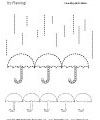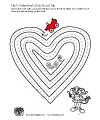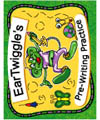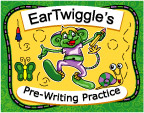Ready for School Activities
building Writing Muscles
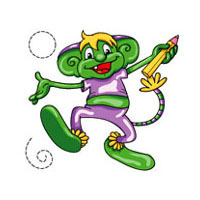
Objectives
Children will develop fine motor skills.
Children will practice writing.
Materials
- Two medium-sized containers
- Two sponges
- Two pitchers of water
Building Writing Muscles
When children are very young, their hand muscles are just beginning to develop the strength and coordination required for writing neatly. Children who have difficulty writing often choose not to write because it’s too tiresome. Help your child build muscle control with these fun, simple activities.
Sponge Squeeze
What you need:
Two medium-sized containers
Two sponges
Two pitchers of water
What you do:
Provide each child with a container, a sponge, and a pitcher of water. Show children how to dip the sponge into the pitcher of water and squeeze it out into the container. Then let children have a race to see who can fill his or her container with water first.
Make a Squeezy Ball
What you need:
Mixing bowl
1 cup cornstarch
1/2 cup water
Food coloring
What you do:
Put the cornstarch in a bowl and slowly add the water, letting your child mix with his or her fingers until all the cornstarch is wet. Add a few drops of food coloring if desired. You should have a putty-like mixture that is pliable and fun to squeeze and roll. If the mixture is too dry, add more water. If it is too wet, add more cornstarch.
When you and your child are finished mixing, give your child the ball and let him or her squeeze it repeatedly. This can be done anywhere: in the car, while watching TV, or while listening to a bedtime story. Try to have your child squeeze it multiple times during the day for at least five minutes.
Store putty in a plastic bag for future squeezing.
Fine Motor Skills
Every child will acquire the fine-motor skills needed for handwriting in a different time table. The more your child uses his/her fingers in activities that help to strengthen their hand coordination, the sooner he/she will master these skills. View some great fine motor skill activities and printables.
Prewriting Skills Tips for Parents and Teachers
A short, soft pencil is easier for small children to hold. If your child is not yet accustomed to using a pencil, a crayon is a good starting tool.
Holding a pencil properly can be difficult for a child who does not yet have enough strength in his or her hands and fingers. Use these fine motor skill activities to help strenghen your child's hand and fingers.
Help your child use relaxed rather than cramped movements as he or she writes.
Demonstrate how to properly grip the pencil between the thumb and pointer finger, letting the pencil rest on the middle finger.
Teach this skill gradually so that your child retains interest and does not become overly tired. To help your child relax, have him or her shake the hands, make drawings in the air, or roll a piece of clay inside the hands.
Keep the writing lesson short — five to fifteen minutes is plenty of time for practice. Stretch the amount of pencil time by incorporating drawing and coloring.
Give a lesson daily, or at least three times a week with our fun pre-writing skill worksheets (available in our KidsSoup Resource Library.).
Additional Resources
For our Newsletter Subscribers:
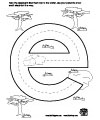
Lowercase Letter E
Pre-writing Worksheet

More Writing Activities

Pre-writing Skills
Before learning to write, it is important that children practice tracing and drawing with a pencil to gain basic pencil-control skills. These activities lead to the ability to form letters and numbers. Provide your child with opportunities to trace and draw in a fun and motivating format. Progress from straight vertical lines to more challenging lines, such as curved, zigzag, and diagonals.





